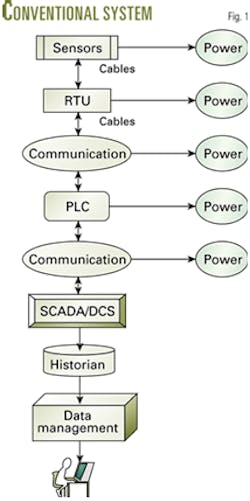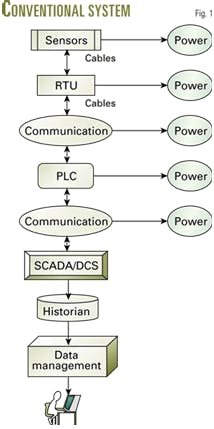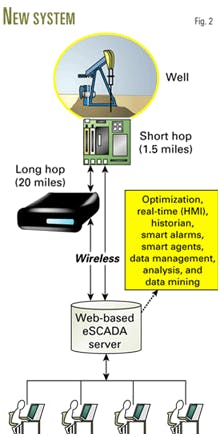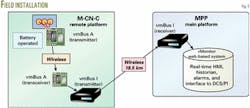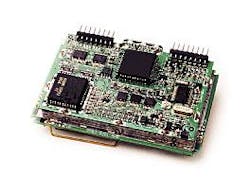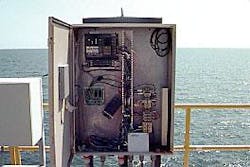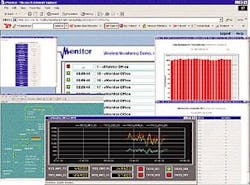Field trial tests web-based wireless eSCADA
Shell Venezuela SA recently proved the transparency and ease of deployment of a wireless data acquisition-communication system and web-based software in its Urdaneta West field, in Lake Maracaibo, Venezuela.
The new automation technology, sometimes referred to as eSCADA (supervisory control and data-acquisition system) provides remote asset management and operations in the upstream oil and gas sector based on wireless and web-based software technologies.
This technology addresses the industry's need for intelligent asset monitoring, control, and data-management systems that lower capital and operating expenses, automate remote assets, provide a better framework for comprehensive data and knowledge management, web-enable information and make it accessible throughout the organization, and provide tools for production optimization and operation diagnostics.
Conventional technology
Conventional automation for remote monitoring, control, and data management for production applications traditionally involves many costly hardware and software components (Fig. 1). As a result, today more than 60% of producing wells worldwide lack automation.
This conventional architecture requires extensive cabling that is costly, especially in offshore applications. These systems also require power for the various instruments, such as sensors, remote terminal units (RTUs), and telemetry systems. These power systems are costly and create many logistical issues.
On the software side, conventional SCADA captures data only at the control-room level, limiting access to critical information. In addition to the SCADA software, many companies install additional software for historians to manage the databases and furthermore implement a data-management system for reporting and analysis of data captured by the SCADA and the historian.
Conventional SCADA never addressed the need for integrated smart decision-support systems for production optimization and intelligent monitoring systems that can analyze real-time and historical data, and compare those data against existing models.
Finally, these systems do not offer an open and flexible architecture that can integrate new automation systems (green fields) with legacy systems (brown fields) from various vendors.
New generation SCADA
Fig. 2, illustrates a more streamlined system architecture. This architecture offers tightly integrated systems with few components at the wellsite. It is wireless and requires low power (battery operated).
Software in this architecture integrates many functions in one. The new generation wireless technology combines data acquisition and wireless communication functions into a single system.
In many instances these wireless systems can replace an RTU at a much lower cost. These devices can take multiple analog and discrete inputs such as 4-20 ma, pulse, etc.
Another advantage of these wireless devices is that they are battery operated with a battery life up to 5 years. The battery can also power certain types of sensors and instruments, such as temperature and pressure.
A new concept of outdoor "wireless mesh" has evolved, whereby multiple wireless units connected to various sensors from multiple assets (wells, etc.) communicate with a hub within 1-1.5 mile radius. This assumes that multiple-data collection points exist within that radius.
At the central hub is a long-range telemetry system that transmits data back to the office via radio, cellular, or satellite, depending on the range. These wireless field devices play the role of data acquisition and communication without any processing at the remote site.
All processing and intelligent functions are at the server in the back-office where data are captured from the hubs.
The web-based software combines several functionalities into one, all in a web-based framework that is a polling engine, real-time kernel, human-machine interface (HMI), alarm, database historian, data analyzer, data miner, and an optimization system. The eSCADA software has several features that extend beyond traditional SCADA systems, such as:
- Optimization capabilities to analyze incoming data and provide a decision-support system for smart monitoring and intelligent control for various applications such as gas lift, electrical submersible pumping, beamlift, well surveillance, and other applications.
- Web enabled, ultra-thin client technology that requires only a browser.
- Open architecture that allows interface to legacy systems from various vendors.
- Data-management tools that allow users to "data mine" the databases and quickly locate relevant information.
- Highly configurable user interface, like a portal, whereby users can customize how to view the data and be able to customize individual reports.
- Web agents that allow users to define processes that can be executed in the background at a scheduled time in order to perform analytical functions or perform complex checks on the incoming data. These processes could be predefined in the system or linked to outside programs.
- Smart alarms that can perform complex monitoring functions on the incoming as well as the historical data.
Venezuela field trial
Shell's recent field trial tested the end-to-end eSCADA system that has a wireless data-acquisition communication system and web-based software. It conducted the field trial on a remote offshore production platform (M-CN-C) in the Urdaneta West field, in the western part of Lake Maracaibo.
The test involved interfacing vMonitor Inc.'s vmBus unit to three analog inputs (4-20 ma) from an existing micromotion transmitter, measuring temperature, pressure, and density.
The test wirelessly transmitted data from M-CN-C back to the main platform (MPP) without running cables on the platforms and without an RTU. Platform MPP is about 19 km from M-CN-C.
The vmBus A operated at 900 Mhz. The unit being tested can handle four analog and four digital inputs. This device without its enclosure is about the size of a credit card. A small lithium battery powers the device.
The vmBus A (transmitter) transmitted the data via a vmBus A (receiver) also on the M-CN-C platform.
The vmBus A (transceiver), interfaced (via RS232 interface) to a long range vmBus I (long-range spread spectrum radio), transmitted the data to Platform MPP, where the vMonitor server hosting vMonitor's web-based TotalAccess software resided.
The software provides web-based, real-time monitoring HMI, smart alarms, reports, historian, and feed data into the Foxboro distributed control system (DCS) and OSI Software Inc.'s PI historian.
After installation of all equipment on the two platforms, one could observe the pressure, temperature, and density reading from the Platform M-CN-C at the main platform, MPP. The TotalAcess software also obtained readings on a laptop server on a boat en route to MPP.
The trial noted that the wireless transmission was uninterrupted and without any interference for an extended period. The web-based software displayed real-time data, generated reports, and stored data in a historian.
After this successful test, Shell started deploying this technology on 12 remote platforms. Each platform has several vmBus A (transmitters) that will be interfaced to various electronic transmitters, and instruments and thermoelements measuring temperature, pressure, and other parameters. This creates a wireless mesh on these remote platform.
This wireless mesh on each remote platform transmits data to a hub, and from that hub (vmBus A transceivers) data goes wirelessly to the main platform, at a distance that ranges from 3 to 18 km from the remote platforms.
Batteries will power most of the vmBus A units, and some units will involve two-way communications for remote control.
The TotalAccess server provides access to the data via Shell's intranet. The software will have real-time HMI, reporting, data mining, smart alarms, and a historical database, as well as an interface to the Foxboro DCS system and another database system from OSI.
The vmBus is a credit-card-sized, battery-operated unit that can handle up to eight analog and digital inputs (Fig. 3).
This vmBus is on remote platform M-CN-C (Fig. 4).
The TotalAccess software provides access to the data through Shell's intranet (Fig. 6).
The authors
Gordon Veitch works on well performance and production system optimization, programming, and planning for Shell Venezuela SA. He has worked 16 years for Shell upstream production operations, primarily in the North Sea.
Gabriela Barboza is an instrument front-end engineer and facilities project coordinator for Shell Venezuela SA. She is the senior project coordinator for the Urdaneta West automation project.
Hatem Nasr is cofounder of vMonitor Inc., a company that provides web-based remote monitoring and data-knowledge management technology for the oil and gas industry. He previously was director of technology at Baker Hughes Inc. and also has worked at Honeywell Inc.'s technology center.
Sami Suheil is projects director at vMonitor Inc., responsible for integrated systems design of remote monitoring systems. His responsibilities include systems design, testing, commissioning, and installations. He previously worked in the telecommunications industry.
